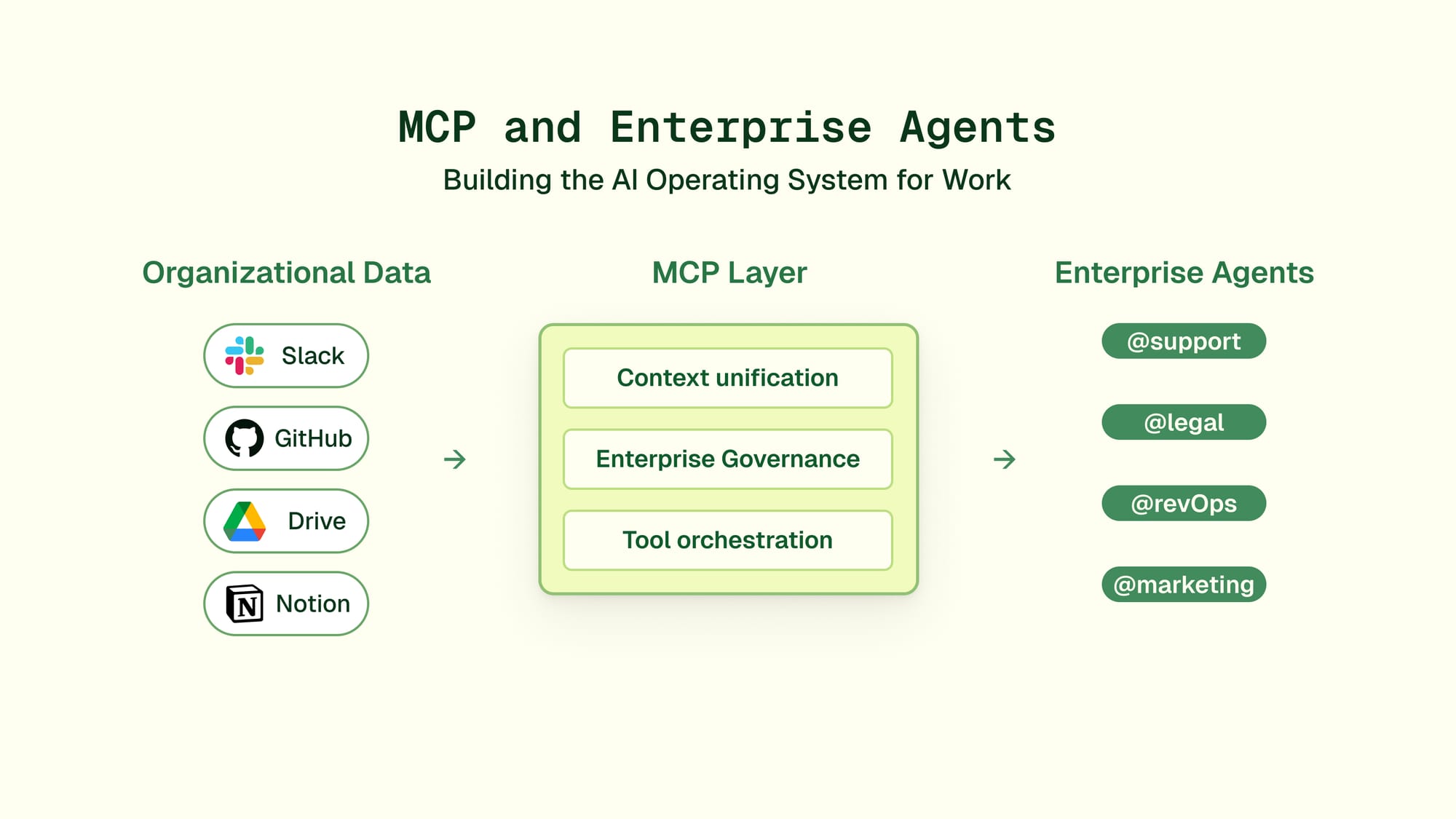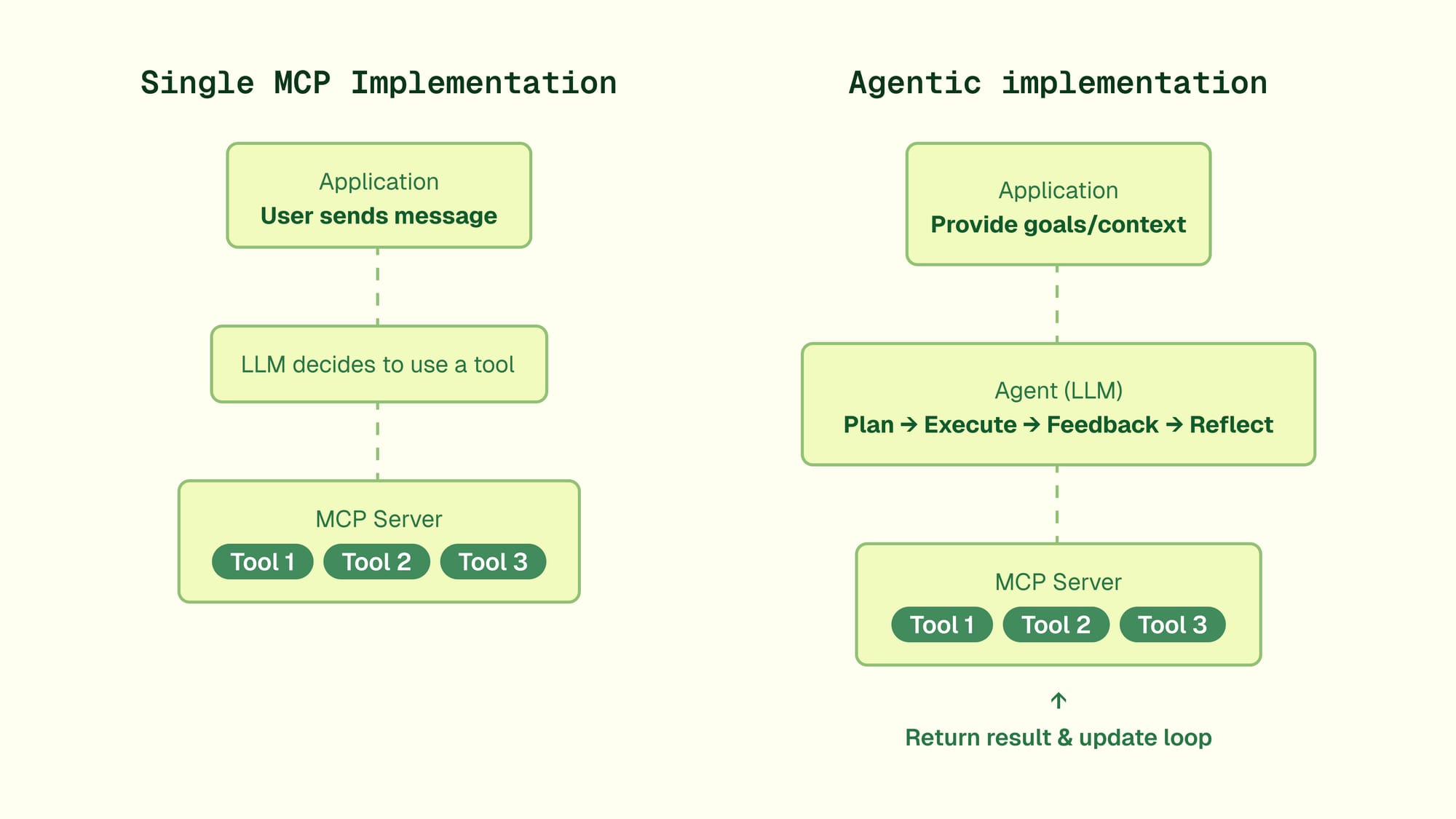MCP and Enterprise Agents: Building the AI operating system for work

The Model Context Protocol (MCP), created by Justin Spahr-Summers and David Soria Parra at Anthropic, has emerged as a popular standard for how AI models interact with tools and data. In its simplest form, MCP functions like a "USB-C port for AI applications"—a universal connector that lets AI systems plug into an entire ecosystem of capabilities without having to build custom integrations for each one. At Dust, we see this as a pivotal development in our mission to transform how work gets done.
After listening to Justin and David's detailed explanation on the Latent Space podcast, we gained valuable insights into what MCP means for enterprise AI and how it aligns with our vision of context-aware, enterprise-safe agents.
True agency vs. simple integration
The MCP creators themselves highlight a fundamental distinction:
"I think you need to define the difference between an MCP server plus client that is just a proxy versus an agent... that difference might be in using a sample loop to create a more richer experience to have a model call tools while inside that MCP server through these clients. I think then you have an actual like agent."
In simpler terms, a basic MCP implementation just passes requests between systems—like a switchboard operator connecting calls. A true agent, however, actively thinks, reasons, and orchestrates complex workflows. It doesn't just connect tools; it understands when and how to use them as part of a broader strategy to accomplish goals. This is the difference between having a directory of phone numbers versus having a skilled assistant who knows exactly who to call and what to ask to get things done.
This insight resonates deeply with our approach at Dust. While basic MCP implementations provide connectivity, true enterprise agents require:
- Company-Wide Context: Access to your organization's complete knowledge ecosystem—from Slack conversations to design documents to support tickets—not just vertical tool data.
- Orchestrated Intelligence: The ability to maintain reasoning loops, coordinate multi-step workflows, and make decisions based on organizational context.
- Enterprise Governance: Operating within carefully defined permission boundaries that respect both data access and action authorization.

Helping intelligent agents tool orchestration
As MCP adoption grows, organizations face a new challenge that the protocol's creators anticipated:
"The dream is certainly like you just furnish all this information to the LLM and it can make sense of everything... But today the practicalities might mean that... maybe you run like a faster, smaller LLM to like filter to what's most relevant and then only pass those tools to the bigger model."
This technical challenge translates to a real business problem: how do you give your teams the power of AI-driven automation without requiring everyone to become an AI expert? When faced with dozens or hundreds of potential tools, even advanced models can get confused about which ones to use and when.
At Dust, we've designed a solution that works for everyone—from AI practitioners who want granular control to enthusiastic users who just want to get work done:
- Flexible Tool Integration for Every Skill Level:
- For Builders: Create custom tools that connect to your specific systems and workflows, with complete control over how they're described
- For Everyday Users: Add tools pre-built by Dust or our community of builders to agents with no coding required
- For Everyone: Trust your agent to automatically select the right tools based on the task at hand
- Multi-Model Architecture: We let users leverage specialized models for different tasks—general models for everyday questions and advanced reasoning models for complex tasks—creating more efficient and effective agents without requiring deep technical knowledge of how LLMs work.
- Context-Aware Tool Selection: Breaking silos without breaking systems, Dust integrates with your existing infrastructure to provide agents with precisely the context they need to choose the right tools at the right time.
This approach doesn't just make agents more capable—it transforms how organizations think about workflows. Traditional workflow automation creates rigid paths that require constant maintenance as systems and processes evolve. Agents built on Dust can dynamically adapt to changing conditions, using the right tools in the right sequence based on the specific situation.
The result? Your teams spend less time designing and maintaining brittle workflows and more time accomplishing meaningful work. Technical teams can create powerful tools that less technical colleagues can easily incorporate into their agents—democratizing AI capabilities throughout your organization while maintaining the governance controls you need.
Client control with enterprise safety
MCP's philosophy emphasizes client control:
"Ultimately, the concept of a tool is not a tool. It's a client application and, by extension, the user. Ultimately, they should be in full control of absolutely everything that's happening via MCP."
This aligns perfectly with our enterprise-grade approach at Dust:
- Admin Layer: Workspace administrators determine which MCP servers/tools are available to agents in their workspace
- User Layer: Individual users can further filter which tools their agents have access to
- Model Layer: The LLM determines which tools to invoke from the filtered set
- Runtime Override: Users can approve/reject tool calls before execution
The Dust approach: transform how work gets done
We're building Dust to serve as both an MCP client and server—the intelligent middleware layer that creates an AI operating system for your company. This approach delivers three core benefits that transform how work gets done across your organization:
- Context-Aware: Our platform integrates with your existing systems to create agents that understand your organization's unique context and workflows. By breaking down information silos without disrupting your systems, Dust enables agents to make connections across traditionally isolated data, delivering insights and automations that point solutions simply can't match.
- Enterprise-Safe: We've built a comprehensive permission framework that addresses the unique challenges of AI agents. Traditional permission models ("Can Alice access document X?") break down when agents need to access data across various systems.This approach means an HR agent can access sensitive policy documents while being safely available to all employees for answering policy questions—similar to how companies maintain separate access policies for data warehouses because the value of unified analytics outweighs the permission management overhead.
- Immediate Impact: Connect your data sources and go from idea to agent in minutes—whether you're in marketing, finance, legal, engineering, or any other department. Every team can leverage AI to enhance their workflows without specialized AI expertise. All without consultants, without coding, and without compromising on security or governance.
The result is transformative for teams across your organization:
- Support teams build agents that access Zendesk tickets, product documentation, and internal knowledge bases to resolve customer issues more efficiently—reducing response times and increasing satisfaction.
- RevOps teams create workflows that span Slack, Salesforce, and Gong without complex integration work, automatically updating opportunity records based on sales meeting output or creating follow-up tasks.
- IT teams deploy compliance checkers that understand company security policies and enforce them consistently across systems—identifying potential issues before they become problems.
- Legal teams build contract review agents that compare new agreements against approved templates and flag potential issues—accelerating review cycles while maintaining compliance.
- Marketing teams create localisation agents that understand brand guidelines, past campaigns, and performance data to help craft more effective messaging—ensuring consistency while reducing production time.
Teams don’t use Dust to automate existing processes only but to enable entirely new workflows that weren't possible before.
As AI agents become more integral to company operations, having a clear system of record for agent permissions becomes as critical as having one for human permissions. Dust provides this foundation, serving as the operating system for the AI-driven company.
Looking ahead: The AI operating system
The future of enterprise AI isn't about vertical smart tools—it's about creating an intelligent layer that spans your entire organization. With MCP providing the protocol foundation and Dust offering the enterprise context and control layer, we're building the operating system for forward-thinking companies.
As the MCP creators note on authorization and trust:
"Companies will need control and visibility on which actions and what data is exposed (how and to which agents) to enable broad deployment of MCP actions within their infrastructure."
This is precisely the challenge we're solving at Dust—creating the secure, flexible, context-aware platform that lets you put AI to work throughout your organization.
Ready to transform how work gets done in your organization? Get started with Dust and build your first context-aware, enterprise-safe agent today.

